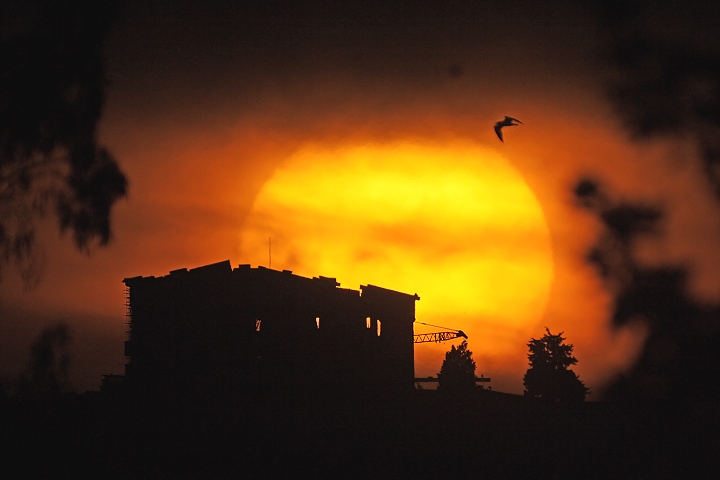
Our sun and closest star is believed to be approximately 4600 million years old and is composed (by mass) of hydrogen (74.5%), helium (23.5%)
and various other heavier elements (2%) such as oxygen and carbon. Due to this gaseous state, the sun does not rotate about its axis at one
uniform rate but has the poles rotating at a slower rate than the equatorial region. It has a central temperature of 14 million degrees
whereas the surface temperature is a mere 5500 °C. With a diameter of 1.4 million km, it is about 109 times as wide as Earth whereas with a
mass of 2 x 1030 kg, it is 335,000 times more massive than Earth. Of interest is the observation that its density of 1400
kg/m3 is only slightly more dense than water (1000 kg/m3).
Although the rising sun may seem to occur at approximately the same azimuth when observed from day to day, a longer term observational
project
will reveal this to be far from the truth. In fact, if we were to mentally note the azimuth of the rising sun around summer solstice in June
and repeat this exercise around winter solstice in December, we will note that the sun has shifted by approximately 65° during the intervening
six months!
This "moving target" involving the rising (or setting) sun is due to the elliptical nature of our planet's orbit around the sun which is
responsible for the variable arrival of the sun on the local meridian by up to 16 minutes early or late and the "Equation of Time" which is
described and documented elsewhere on this site along with the variable altitude due to
earth's tilt in its axis of rotation (23.45°) relative to its orbital plane.
Note: The image below is the culmination of yet another prolonged effort to capture the rising sun against the
Parthenon (447-438 BC) in central Athens and which was finally realized in early May/2009. The primary task in such an exercise is to
precisely reverse engineer the perspective of the Parthenon with respect to its physical azimuth and altitude from my shooting location
approximately 5.12 kilometers southwest of the Acropolis and the primary highway which connects Peiraeus and Athens with northern Greece. Such
a distance was desireable so as to have a greater balance between the apparent size of the Parthenon in the foreground and Sol in the background
and as indicated by the image below. Three other efforts and results and in addition to the image below are available
here,
here and
here.
Note: For additional photos of the sun and/or full moon against other well-known Greek archaeological grounds
and sites, please click
here and/or
here.
|
Body: Sun Mass: 332,900 x Earth Mean Eq Diameter: 109.1 x Earth Distance: 151 million km RA / Dec: 03h 36m 15s / +19° 20' 27" Diameter: 31.63' Magnitude: -26.8 |
 |
Date: May 17, 2009 06:23:25 UT+3 Location: Athens, Greece Equipment: Takahashi FSQ 106/f5 AP 2x Conv Barlow Canon EOS 350XT Meade 4000 Lunar Filter Baader UV/IR-Cut Filter Exposure: 1 x 1/1250 sec ISO 400 RAW image format 3456x2304 image size Manual Mode Software: Digital Photo Pro V1.6.1 Photoshop CS2 Processing: RAW to TIFF (16-bit) Conv Resampling JPG Compression |